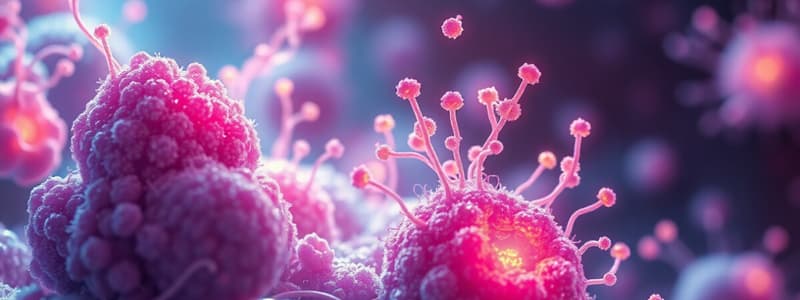Podcast
Questions and Answers
A researcher is working with a bacterial species that requires a specific set of vitamins and amino acids to grow. Which type of culture media would be most suitable for cultivating this organism?
A researcher is working with a bacterial species that requires a specific set of vitamins and amino acids to grow. Which type of culture media would be most suitable for cultivating this organism?
- Differential media
- Selective media
- Enriched media (correct)
- Defined media
In a microbiology lab, a student needs to prepare a culture medium that will allow only Gram-negative bacteria to grow while inhibiting the growth of Gram-positive bacteria. Which type of media should the student use?
In a microbiology lab, a student needs to prepare a culture medium that will allow only Gram-negative bacteria to grow while inhibiting the growth of Gram-positive bacteria. Which type of media should the student use?
- Defined media
- Selective media (correct)
- Differential media
- Complex media
A microbiologist is investigating the motility of a bacterial species. Which form of culture media would be most appropriate for this study?
A microbiologist is investigating the motility of a bacterial species. Which form of culture media would be most appropriate for this study?
- Selective media
- Liquid media
- Solid media
- Semi-solid media (correct)
To ensure that a newly prepared batch of nutrient broth is free from any living microbes, what sterilization method is most commonly used?
To ensure that a newly prepared batch of nutrient broth is free from any living microbes, what sterilization method is most commonly used?
A researcher needs to prepare a solution containing 5 grams of NaCl in 100 mL of water. Which type of solution is the researcher preparing?
A researcher needs to prepare a solution containing 5 grams of NaCl in 100 mL of water. Which type of solution is the researcher preparing?
In a laboratory experiment, a buffer solution is used to maintain a stable pH in a culture medium. What is the primary reason for using a buffer?
In a laboratory experiment, a buffer solution is used to maintain a stable pH in a culture medium. What is the primary reason for using a buffer?
A microbiologist is studying a bacterium that thrives in highly acidic environments. Which of the following pH ranges would be most suitable for culturing this bacterium?
A microbiologist is studying a bacterium that thrives in highly acidic environments. Which of the following pH ranges would be most suitable for culturing this bacterium?
A researcher observes that the pH of a culture medium has significantly changed after autoclaving. What is the most likely explanation for this change?
A researcher observes that the pH of a culture medium has significantly changed after autoclaving. What is the most likely explanation for this change?
When preparing a culture medium, a scientist needs to add a solidifying agent. Which of the following is most commonly used for this purpose?
When preparing a culture medium, a scientist needs to add a solidifying agent. Which of the following is most commonly used for this purpose?
In a research lab, different types of bacteria are grown on a medium that allows researchers to visually differentiate between them based on their metabolic byproducts. What type of medium is being used?
In a research lab, different types of bacteria are grown on a medium that allows researchers to visually differentiate between them based on their metabolic byproducts. What type of medium is being used?
Flashcards
Defined Media
Defined Media
Media with precisely known chemical composition.
Complex Media
Complex Media
Media containing ingredients of unknown composition (e.g., yeast extract).
Selective Media
Selective Media
Media that allows specific microorganisms to grow while inhibiting others.
Differential Media
Differential Media
Signup and view all the flashcards
Autoclaving
Autoclaving
Signup and view all the flashcards
Solution
Solution
Signup and view all the flashcards
Percent Solution
Percent Solution
Signup and view all the flashcards
pH
pH
Signup and view all the flashcards
Acidophile
Acidophile
Signup and view all the flashcards
Buffer
Buffer
Signup and view all the flashcards
Study Notes
- Culture media are essential for growing microorganisms in the laboratory
- They provide the nutrients and conditions necessary for microbial growth
Types of Culture Media
- Defined media (synthetic media) have a precisely known chemical composition
- Complex media contain ingredients of unknown chemical composition, such as yeast extract or peptone
- Selective media allow the growth of specific microorganisms while inhibiting others
- Differential media distinguish between different types of microorganisms based on their metabolic activities
- Enriched media are supplemented with specific nutrients to support the growth of fastidious microorganisms
Components of Culture Media
- Water is essential as a solvent and for maintaining osmotic balance
- A carbon source provides energy and building blocks for microbial growth (e.g., glucose)
- A nitrogen source is necessary for protein and nucleic acid synthesis (e.g., peptone, amino acids)
- Inorganic salts and minerals are required for various enzymatic activities and cellular functions
- Growth factors are specific organic compounds needed by some microorganisms (e.g., vitamins, amino acids)
- Buffers help maintain a stable pH
- Agar is a solidifying agent used in solid media
Forms of Culture Media
- Liquid media (broths) are used for growing large quantities of microorganisms
- Solid media (agar plates or slants) are used for isolating pure cultures and observing colony morphology
- Semi-solid media are used for motility studies
Preparation and Sterilization of Culture Media
- Culture media must be sterilized to eliminate contaminating microorganisms
- Autoclaving is a common sterilization method using high-pressure steam (typically 121°C for 15-20 minutes)
- Filtration is used for heat-sensitive media components
- After sterilization, media should be stored properly to prevent contamination
Solutions in Basic Microbiology
- Solutions are mixtures of a solute dissolved in a solvent
- Aqueous solutions use water as the solvent
- Solutions are used for various purposes in microbiology, including:
- Preparing culture media
- Diluting samples
- Performing staining procedures
- Preparing disinfectants
Types of Solutions
- Molar solutions are based on the number of moles of solute per liter of solution
- Percent solutions express the concentration as grams of solute per 100 mL of solution
- Normal solutions are based on the number of equivalents of solute per liter of solution
- Stock solutions are concentrated solutions that are diluted to the desired concentration before use
Common Solutions in Microbiology
- Saline solutions (e.g., 0.85% NaCl) are used for suspending cells and maintaining osmotic balance
- Buffers (e.g., phosphate buffer) are used to maintain a stable pH
- Disinfectant solutions (e.g., bleach, alcohol) are used for sterilization and disinfection
- Staining solutions (e.g., Gram stain reagents) are used for microscopic examination of microorganisms
pH in Basic Microbiology
- pH is a measure of the acidity or alkalinity of a solution
- It is defined as the negative logarithm of the hydrogen ion concentration (pH = -log[H+])
- The pH scale ranges from 0 to 14, with 7 being neutral, values below 7 being acidic, and values above 7 being alkaline
- Microorganisms have optimal pH ranges for growth
- Most bacteria grow best at neutral pH (around 7)
- Fungi typically prefer slightly acidic conditions (pH 5-6)
- Extremeophiles can tolerate very acidic or alkaline conditions
Importance of pH Control
- Maintaining the correct pH is crucial for microbial growth and enzyme activity
- pH affects the ionization of molecules and can alter protein structure
- Buffers are used to maintain a stable pH in culture media and solutions
- Common buffers used in microbiology include phosphate, Tris, and MOPS buffers
- pH can be measured using a pH meter or chemical indicators
- A pH meter provides a precise electronic reading
- Chemical indicators change color depending on the pH
- Sterilization affects pH
- Autoclaving can alter the pH of some media
pH and Microbial Growth
- Each microbial species has an optimal pH range for growth
- Acidophiles grow best at acidic pH values (pH 0-5)
- Neutrophiles grow best at neutral pH values (pH 6-8)
- Alkaliphiles grow best at alkaline pH values (pH 9-11)
- pH affects nutrient availability: Solubility of certain nutrients changes with pH
- pH affects enzyme activity: Enzymes have optimal pH ranges for activity
- pH affects membrane stability: Extreme pH values can damage cell membranes
Studying That Suits You
Use AI to generate personalized quizzes and flashcards to suit your learning preferences.




